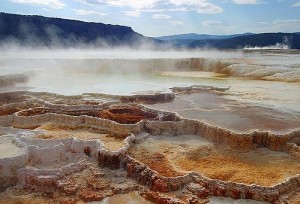The current Yellowstone earthquake swarm is now “the second-largest ever recorded in the park,” according to researchers quoted in the NY Times.
Shortly after 1 AM this morning, the 1st of February 2010, I awakened and was lying in bed listening to the quiet of the night. No traffic disturbed the silence as the city slept in anticipation of Monday morning and the new work week. Then around 1.15 AM I heard a sudden loud, sharp cracking sound coming from my house, similar to the settling of an old building. The noise surprised me since my house is extraordinarily quiet other than seasonal creaking associated with a massive elm’s root growth cycle.
My first thought? Yellowstone. Yes, Yellowstone.
There will, of course, be naysayers out there who will write off what I’m about to report as a simple coincidence. But statistically speaking, this event stands out. After all, I’d never before thought that any noise in my house was possibly related to seismic activity occurring 600 miles away.
Yet somehow, quickly and intuitively, I made a connection between the sound I’d just heard and Yellowstone. I noted the time on my fairly-accurate bedside clock and determined that first thing in the morning I’d check out the Yellowstone quake log posted by the USGS to see if I could link the unusual cracking sound I heard a little before 1.15 AM with a quake.
Sure enough, this morning I booted up the computer and here’s what I found: a modest, magnitude 2.6 quake rumbled under Yellowstone at 1.11 this morning, Monday the 1st of February. More precisely, the USGS site noted the time of the quake as 08:10:42 UT, which is 7 hours ahead of Mountain time, and just moments before I heard the noise – accounting for the time it takes for seismic waves to travel through the Earth’s crust.
So even though I didn’t feel the Earth move, my house may have registered the quake with a bit of shifting and creaking that could easily be dismissed if certain “earthquake risk factors” I’ve written about recently didn’t exist.
For instance, an almost-overlooked mild solar wind stream arrived on the 30th, stirring up Earth’s geomagnetic field and resulting in some nice Norwegian auroras. And last night when I got up after hearing the sound, the extraordinary glow of 2010’s perigee moon bathed the house in a soft glow that enchanted me on the one hand, and on the other made me wonder if the moon’s gravity might result in increased gravitational pull on Earth’s stressed tectonic plates. Finally, Yellowstone hadn’t had a magnitude 2 quake in a couple of days.
With all these factors in place, pressure would likely build.
Even though I can’t prove the noise was in any way related to the quake, when it happened there was absolutely no rationalising, no sign of Occam. There was simply a knowing, and there still is, that Mother Earth is speaking – and if we listen hard enough, we just might get her message.
STACE TUSSEL
Addendum: A small earthquake (mag 2.5) hit near Oklahoma City the same day I wrote this article. A line between Yellowstone and the Oklahoma quake zone near Oklahoma City just skirts the northeastern part of the Denver metro area. Coincidence, or part of a linked fault line? I’m simply mentioning it as food for thought…

